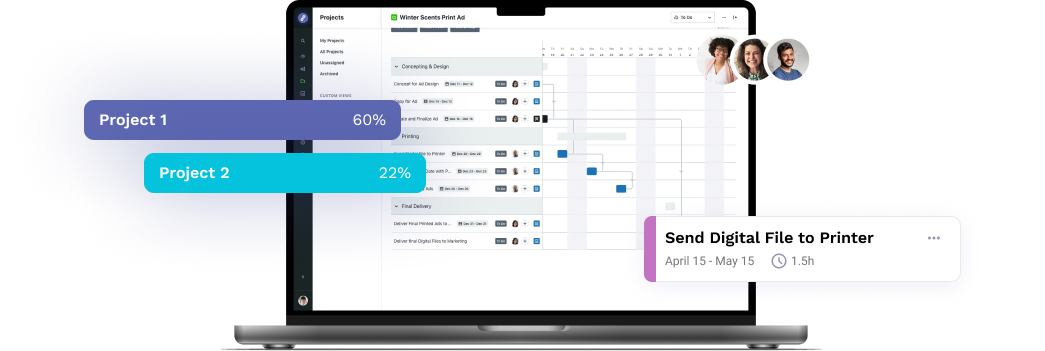
When creative teams discuss how to set up a project for success, an effective creative brief sits at the top of their list. In fact, the effectiveness of a creative brief is always reflected on the success, or lack thereof, of the project itself. A proper brief is the greatest gift you can give to everyone involved in a project. Please watch the following short film that perfectly outlines the history and reality of briefs:
Why Is a Creative Brief Important?
The ideal creative brief allows your team to coordinate better. It also helps everyone involved to align with client expectations properly. Effective creative briefs also foster better relationships among team members, which will also allow for collaboration to prosper. At the end of the day, the brief should be available and easily accessible to the team. It helps to think of it as the foundation of the project. There are a few notable characteristics that you should find in well-written creative briefs. They are bound to help you get your next project kicked off without a hitch. Without further ado, here is what a creative brief should be:
How Do You Write an Effective Creative Brief?
1. Make It Clear: If you have not define your project well enough, then you will be faced with a lack of clarity. This can definitely result in things going haywire at some point in the process. In collaborative settings, it is crucial that you help align all members working together to achieve the same goal. Go above and beyond to understand your client’s business, services, and needs. This will ensure your brief is on track with what the customer wants. Once you have that defined, the rest of the project will follow through seamlessly.
2. Be Concise: An effective creative brief should, ideally, be two pages long. When you are researching your client’s business, industry, and scope, you may end up suffering from information overload. This is why it is best that you keep your creative briefs are short and sweet. Make sure that you condense all relevant information appropriately. As long as you only include what is necessary, your brief will be effective and well-received. Your peers always appreciate it when what you hand them is not a novel-long creative brief to dive into.
3. Be Communicative: Communication is huge in a team setting. The creative brief is meant to clearly communicate information from the client to your creative team and vice versa. When your creative brief fails to send the right message, then chances are the client will receive something wildly different what they had requested. Fear not – there is an easy fix for this. Use language that is easy to understand and stay away from vague wordy sentences. Remember, the goal of the creative brief is to get the right message across. Save your impressive storytelling skills and vocabulary for the assignment itself and you’ll do just fine!
What and Who Should Your Brief Address?
Along with clarity, conciseness, and communicability, your creative brief should also address key considerations including:
- Product – Each brief should be tailored to the product the resulting project will be focusing on.
- Market – Tailor your brief around the specific market or industry your clients operate in.
- Customer – Different target groups call for different creative briefs.
A well-written creative brief is basically the crowning jewel of project kickoff. It allows the rest of the project to be carried out with efficiency and clarity. Make sure you follow our tips when writing your next creative brief and watch as you reap the benefits of doing everything right from the get-go!
Is an Effective Creative Brief Alone Enough?
Here at Lytho, we have been conducting research on the challenges that creative teams and their leaders face since 2018. Each year, we publish our findings on our Creative Management Report. Starting in 2022, we have switched to a quarterly cadence – download our latest report here.
Our findings suggest that project-related requests have been a major source of frustration between creative teams and clients. 38% of creative teams experience unexpected changes to work that’s on the final stages of production. Another 40% of creative teams struggle with unclear on incomplete requests that lengthen conversations and push back project delivery deadlines. And all this results in 48% of creative teams experiencing very tight deadlines, leaving them with insufficient time to make the right strategic and creative decisions.
Needless to say, this reduces the overall quality of the product. Well-thought-out creative briefs may just be what is missing for creatives and agencies to collaborate more efficiently.
Read More on Creative Briefing:
Dynamic Form Template Builder: Revolutionize Your Creative Briefing Process
How Do You Perfect Your Creative Request Intake Process? Our Tips
Do you want access to creative brief templates and advanced automation across the board? Lytho helps you streamline your entire workflow and harmonize all brand collateral under a single, uniform platform. Feel free to reach out to us by scheduling a demo and learning how our creative solutions can boost the effectiveness of your creative projects. We look forward to speaking with you!
Do you want to give yourself and your creative team more room for creative stimulation by automating the boring stuff? Lytho helps you streamline your entire workflow and harmonize all brand collateral under a single, uniform platform. Feel free to reach out to us by scheduling a demo and learning how our creative solutions can boost the effectiveness of your creative projects. We look forward to speaking with you!

Ready to simplify your creative operations and start having a little fun at work again? Schedule time to talk with us.
Let us show you how Lytho’s Creative Operations Platform helps in-house creative and marketing teams do better work, ease the stakeholder experience, and stay on brand.
Schedule a Demo